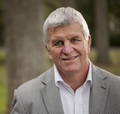Smart strategies in action
This quarter, we are updating our strategy which means we are thinking hard about how Scion can further help the forest industry to generate ‘prosperity from trees’ more efficiently and in new ways.
Trees are enormously versatile and much of their potential is only now being tapped as the world confronts issues such as climate change and natural resource scarcity. These pose big challenges - and opportunity - for New Zealand with respect to building an international competitive bio-based economy. Such environmental pressures coincide with demographic and geopolitical shifts; machines replacing jobs; heightened cyber risk; and rapid innovation through the systemisation of existing technologies. As Michael Porter and James Heppelmann from Harvard University contend, ‘“smart, connected products” – made possible by vast improvements in processing power and device miniaturisation and by the network of ubiquitous wireless connectivity - have unleashed a new era of competition' 1.
This set of external factors provides a rich environment of possibilities for the forest industry and the biomaterial sectors Scion works with. It also demands from us new ways of thinking and working. Albert Einstein’s observation “We cannot solve our problems with the same thinking we used when we created them” is just as salient for the Board rooms and policy agencies we work with, as it is for Scion’s science teams.
Collaboration – across disciplines; with firms within and between value chains; and across cultures and countries – is a growing feature of our science. That means we need better skills for working efficiently and influentially in large, multi-party programmes such as National Science Challenges and the Industrial Symbiosis project soon to get underway. It also means we are giving more attention to how sectors complement each other, for example dairy and forestry, forestry and renewable energy, in order to achieve sustainable growth and greater economic resilience.
Several years ago we identified the need to build new and additional science expertise in Value Chain Optimisation, Forest Industry Informatics and effective use of ‘big data’, and resource economics. We have recently recruited excellent staff in all of these domains, including two Science Leaders. They are allowing us to address industry priorities of improving operational efficiency within the supply chains we work with, implement precision forestry and value the environmental contribution of forestry.
All three capabilities underpin our growing emphasis on the ‘smart application’ of existing technologies. This is well illustrated by our purchase of a UAV, high quality remote sensing equipment and large data set analytical capability in order to provide a fast, cost-effective forest management for small-medium scale foresters, as well as new services for large forest owners. At the same time we have entered a strategic collaboration with a firm specialising in UAV technology and partnered with some forest owners to rapidly develop the proof-of-concept.
This epitomises our strategy in action – ensuring we have excellent core capabilities (including from students and post-doctorates) and equipment; establishing early end-user and private sector partnerships with a clear focus on problem-solving and future value generation; and forming strategic collaborations with domestic and offshore leaders in fields of shared interest. Concurrently, appropriate commercialisation pathways are being identified such as the Kiwi Innovation Network which we recently joined (see article). Our culture is changing to match this. We are becoming more agile in decision making and global in outlook, undertaking more multi-disciplinary research and are more reliant on our customers for market insight and co-creation of solutions to ensure their early uptake. Core funding and reinvestment of surpluses provides the essential financial resources Scion needs to execute its strategy well.
This edition of Scion Connections illustrates some of our recent strategic developments and progress on programmes already in place, and features some of the great new staff we have recruited. As always please feel to contact me directly or any of the named scientists with any comments or questions you might have.


Dr Warren Parker
Chief Executive
